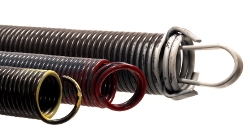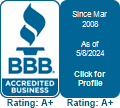High Lift Garage Door Conversion
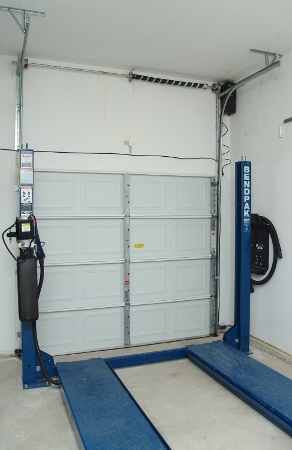
Table of Contents
- Introduction to High Lift Conversions
- Measurements and Calculations Get a custom high-lift conversion kit quote for your door.
- Getting Started: Safety First!
- Remove Your Hardware.
- Prepare for Installing High Lift Hardware.
- Install High Lift Hardware.
- Reinstall Your Track and Bearing Plate.
- Install the Spring Anchor Bracket.
- Assemble the Hardware on the Shaft.
- Install the Torsion Spring and Cable.
- Wind the Torsion Spring or Springs.
- Basic Garage Door Maintenance
- Conclusion
1. Introduction to High Lift Conversions
2. Measurements and Calculations Get a custom high-lift conversion kit quote for your door.
Please note: If you have already raised your garage door tracks, or if you raised the tracks and your door doesn't work, please contact us. Filling out the inquiry form will not be necessary as we process these with different software.
| 2.1. In order to fabricate a custom high lift track assembly and to determine the cable length and springs needed, you will need to provide us with the information in this and the following steps. Measure the width and height of your door. Measure the distance from the jamb to the back of the top of the vertical track. This is your track-to-jamb dimension. Note: This flag bracket will be replaced with a new track bracket. | 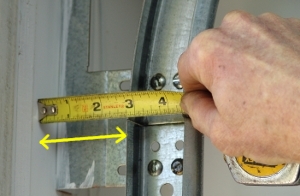 |
 |
2.2. Measure the radius of the curved portion of the horizontal track. This can be done by placing a level at the junction of the horizontal and vertical track, holding it level, and measuring the distance between the bottom of the the horizontal track and the level as shown. This is normally 12 or 15 inches. |
| 2.3. Measure the distance from the floor to the ceiling at both ends of that garage door opening. If one side is shorter than the other, use the shorter distance. Subtract the space you will need above your garage door for lights, an opener, or other objects. This is your floor to ceiling dimension. | 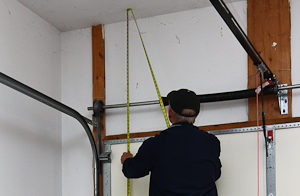 |
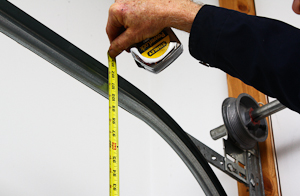 |
2.4. Measure the distance from the floor to the top of the straight portion of the horizontal track. This measurement should be made just past the end of the curved portion of track. |
| 2.5. The next few steps will help you determine the weight of your garage door. There are two ways to do this. One is to identify your cable drums and door height and to measure your spring or springs. Look at your cable drums. They should have information written on them on the inside of the drum (as pictured) or on the rim of the drum (the part that has black and white paint on it in the picture). |  |
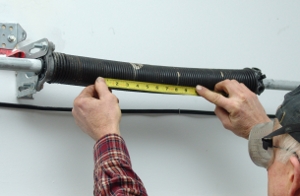 |
2.6. Measure your existing torsion springs. For more information on how to do this, go to our How to Measure Torsion Springs page. If you provide your spring dimensions, door height and cable drum information, we will determine the weight of the door. This method will work only if you are certain of the dimensions and that the door worked fine with the existing spring or springs. |
| 2.7. The second way to determine the weight of your garage door is to weigh it. Use an analog scale. Digital scales tend to be less accurate because they usually do not change the displayed weight after it makes the initial calculation. As pictured, you may need to place boards under the scale to have a level surface. It would be easier to do this with the spring unwound. See our How to Weigh a Garage Door instructions for more information. | 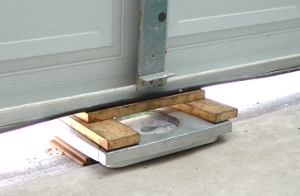 |
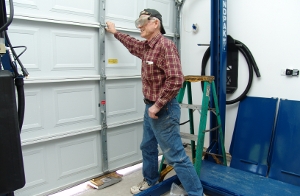 |
2.8. Shake the garage door. Sometimes the door gets stuck on the track and shaking the door will give you the proper weight. Read the weight of the garage door off of the scale. This helps us determine the springs that you need. Check also for outside handles or locks. If these are present, can they be removed? If they can not be removed, additional parts and labor will be needed to provide clearance for the handles. |
In summary, you need to supply us with the following information when you contact us for a price for a high lift conversion kit for your garage door:
- Door width and height (2.1)
- Track to jamb dimension (2.1)
- Horizontal track radius (2.2)
- Floor to Ceiling dimension (2.3)
- Floor to top of horizontal track (2.4)
- Drum number and spring dimensions or garage door weight (2.5, 2.6, 2.7, 2.8)
- Outside lock and handle information
You'll also want to consider the wind of the spring if you have only one, and conversion from one to two springs if that becomes necessary. In these instructions we replaced a single spring with another single spring that had the same wind. The customer had installed a pad up above and finished it with drywall. You will need to check the area above your header for studs or pads for mounting the spring anchor bracket, as well as the track angle that supports the track extension. Often additional framing will be necessary.
In addition, we often recommend converting to two springs for high lift. If you are converting to two springs, or if you already have two springs, we recommend reviewing our instructions for replacing garage door springs. Pay particular attention to the wind of the springs. The winding cone with red paint on it is normally installed on the left side of the center support bracket, and the spring with black paint on the winding cone is installed on the right side of the bracket.
3. Getting Started: Safety First!
As with our torsion spring replacement page and our torsion spring price lists we begin this tutorial with our sternest warning:
CAUTION: Torsion spring replacement is dangerous because the springs are under tension. If you do not use the right tools and follow safe procedures, you could lose fingers, limbs or even your life. You could also damage property. We want your business, but not at the expense of your well being. Doing the job right is your responsibility. If you have any doubts about your ability to perform the work safely, we recommend you hire a professional.
| 3.1. Two important assumptions will help you perform this work safely. First, assume that the spring is going to break as you unwind or wind it. To avoid injury clutch the bars firmly on the ends furthest away from the cones and stand securely on a sturdy ladder, not on chairs or cans turned upside down. Keep clothes and body parts away from the spring. Wear safety glasses. |  |
 |
3.2. Second, assume that the cone is going to slip or explode as you unwind and wind the spring. Keep your head out of the path of the winding cone. Keep your hands away from the cones so that if and when the winding bar slips out of the cone and your hand jerks up, the cone doesn't rip your flesh or wrap your clothes and body parts into the spring. |
| 3.3. Beware of older winding plugs. These older Crawford and McKee spring cones were made for 5/8" bars. Do not try to unwind or wind one of these springs with 1/2" bars. |  |
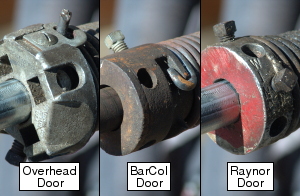 |
3.4. Older Overhead, BarCol and Raynor winding cones often have inconsistent hole sizes. If you insert a 1/2" X 18" bar in some of these holes you can move the opposite end of the bar over four inches. Bars in newer cones move less than 1 1/2". I've had many of the older cones spin loose from my bars, the last one generating an $1800 emergency room bill. If your cones are like any of these, or if they have more than two inches of play, leave the job of installing torsion springs to a professional. |
| 3.5. To begin, gather the tools you'll need. You'll need a minimum of one or two 10" vise grips, an adjustable wrench, and two 1/2" X 18" winding bars. Most hardware stores sell 1/2" X 36" steel rods that can be cut in half. You'll also need a firm ladder. A ruler and a file may also be needed, and a socket wrench and sockets would shorten the time required. You will also need a hacksaw, a drill and an electric impact wrench if available. | 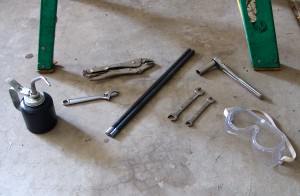 |
4. Remove Your Hardware.
| 4.1. If you already had an operator on your garage door, dismount it and remove it from the garage door. If you have a drawbar opener on your garage door, remove it before converting to high lift hardware. | 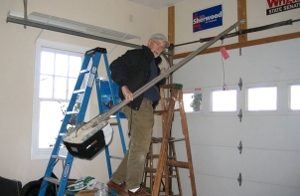 |
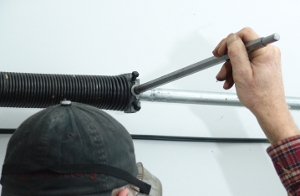 |
4.2. You are now ready to unwind your old spring if you have not done so already. Since high lift garage doors need to be held open by the torsion springs even after the door has been opened, you need new torsion springs. Refer to section six of our Double Torsion Spring Replacement tutorial. |
| 4.3. Remove the spring anchor bracket from the wall. | 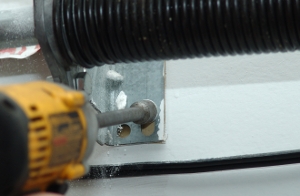 |
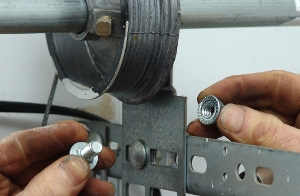 |
4.4. Remove the carriage bolts that secure the end bearing plate to the horizontal track. |
| 4.5. Remove the lag that secures the end bearing plate to the garage door header. The shaft should sit on the angle connecting the horizontal shaft to the flag bracket as shown. Remove any other carriage bolts that support the end bearing plate. | 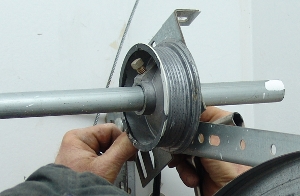 |
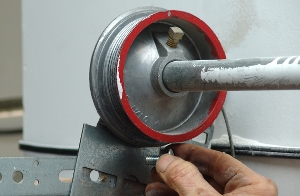 |
4.6. Remove the end bearing plate on the other side of the garage door from the horizontal track and the garage door header. |
| 4.7. Remove the cable from both cable drums if it has not already fallen out. | 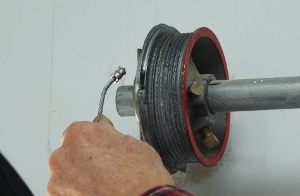 |
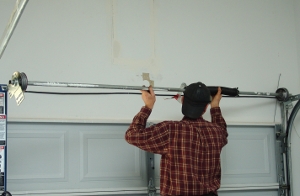 |
4.8. Remove the shaft from the garage door. |
| 4.9. Set the shaft on the floor. You will now remove the hardware from the shaft. | 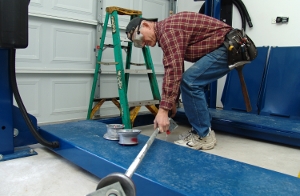 |
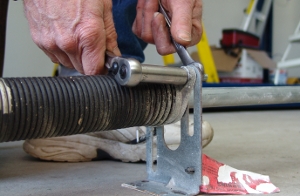 |
4.10. Remove the bolts that secure the stationary cone to the spring anchor bracket. If you do not have a slotted spring anchor bracket, you do not need to remove it from the shaft for the high lift conversion. |
| 4.11. You will want to keep the spring anchor bracket since you can reuse it for your new torsion springs on your high lift garage door. | 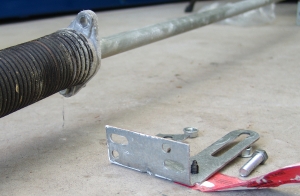 |
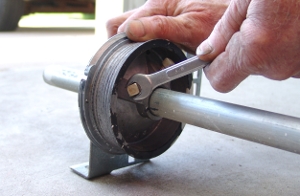 |
4.12. Loosen the set screws that secure the cable drum to the shaft. Note that the cable drum that was on the right side of the garage door is painted black. |
| 4.13. Slide the end bearing plate and the cable drum off the shaft. You can reuse your end bearing plates on your high lift door. If the bearing is worn or the end bearing plate is bent, you should probably replace them. We sell the parts in our catalog, and we provide a tutorial for replacing the bearing. | 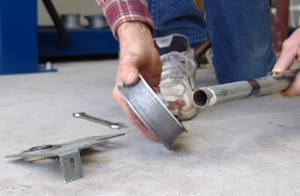 |
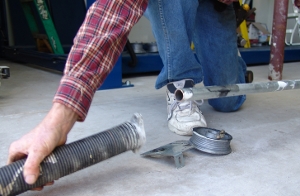 |
4.14. Slide your old torsion spring off the shaft. |
| 4.15. Remove the bushing that was inside the stationary cone if it did not already come out. You will be reusing this unless you ordered a new steel bearing. NOTE: Even if you are installing two springs for your high lift torsion assembly, you will not need a second bushing. The purpose of the bushing is to keep the shaft from wearing on the spring anchor bracket. Only one is needed to do this. If you install a bushing or bearing in both stationary cones, you run the risk of breaking one of your cones. | 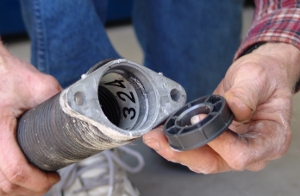 |
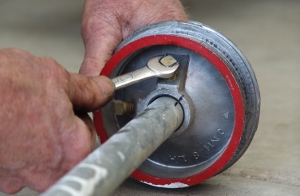 |
4.16. Loosen the set screws on the other cable drum. |
| 4.17. Remove the cable drum and end bearing plate. | 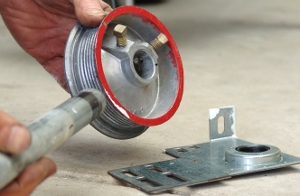 |
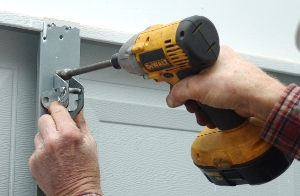 |
4.18. Remove any other opener parts used on the garage door. |
| 4.19. Drive a nail in the header just above the top of the garage door. | 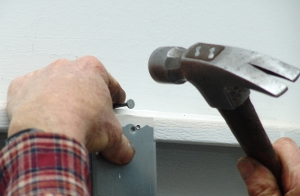 |
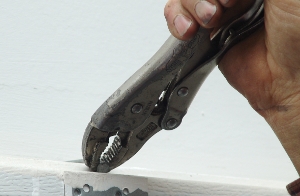 |
4.20. Bend the nail over the top of the garage door with a vise grip. |
| 4.21. The nail here will keep the top section of the garage door from falling over when we remove the horizontal track. | 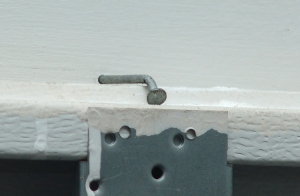 |
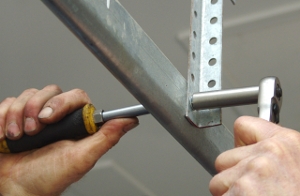 |
4.22. Loosen the bolt that secures the end of the horizontal track to the angle iron. Do not remove the bolt yet. Do this on both sides of the garage door. |
| 4.23. Remove the bolts that secure the horizontal track to the flag bracket just above the top of the vertical track. | 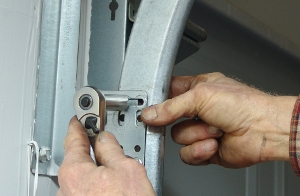 |
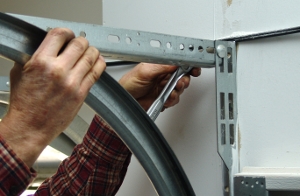 |
4.24. Remove the bolt that connects the horizontal track to the flag bracket. Caution: Hold on to the horizontal track so it will not fall when you remove this bolt. |
| 4.25. Lift the horizontal track until the bottom is higher than the top roller. Loosen the nuts that secure the top roller to the top fixture. | 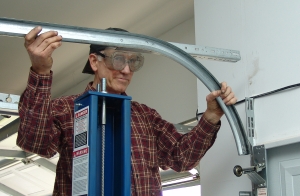 |
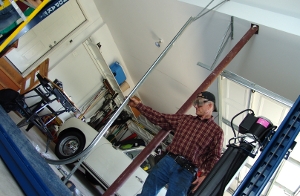 |
4.26. Bring the horizontal track down and let it hang from the angle iron. |
| 4.27. Remove the bolt that secures the horizontal track to the angle iron. | 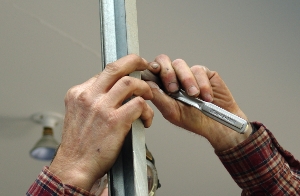 |
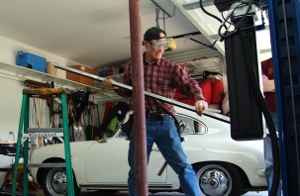 |
4.28. Lower the horizontal track to the floor. |
| 4.29. Move to the other side of the garage door and repeat the process. Start by removing the bolts that connect the horizontal track to the flag bracket just above the vertical track. | 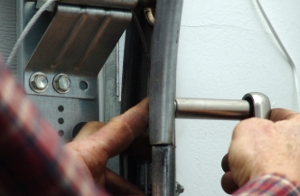 |
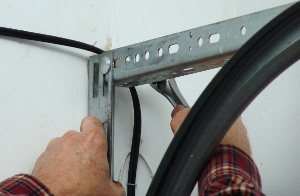 |
4.30. Remove the bolt that connects the horizontal track to the flag bracket above the garage door. Caution: Hold on to the horizontal track. It will want to fall when you remove this bolt. |
| 4.31. Pull the track out of the flag bracket and above the top roller. | 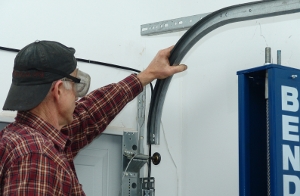 |
 |
4.32. Swing the track down. |
| 4.33. Remove the bolt connecting the horizontal track to the track hang. | 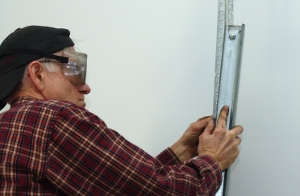 |
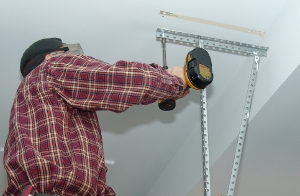 |
4.34. Remove the track hangs from the ceiling on both sides of the garage door. |
5. Prepare for Installing High Lift Hardware.
| 5.1. Make a mark with a pen or marker at the bottom of the flag bracket on the inside. | 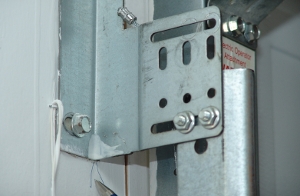 |
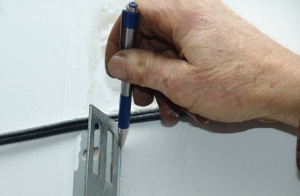 |
5.2. Extend this line up the whole length of the flag bracket, using the inside edge of the flag bracket as a straightedge. |
| 5.3. Extend this line higher with a level, making sure that it is plumb. | 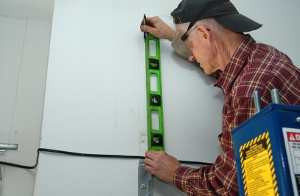 |
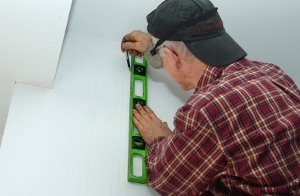 |
5.4. Draw the line all the way up to the ceiling. |
| 5.5. Repeat this process on the other side of the garage door. |  |
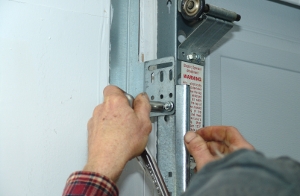 |
5.6. Remove the bolts that secure the flag bracket to the vertical track. |
| 5.7. Remove the lag screws that secure the flag bracket to the jamb. You will not need this flag bracket for your high lift garage door. |  |
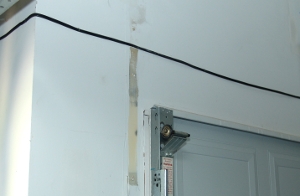 |
5.8. The wall should look like this, with nothing on the outside of the top roller. |
| 5.9. Remove the flag bracket from the other side of the garage door. |  |
 |
5.10. Loosen both top roller carriers if you have not done so already. |
| 5.11. Using a stud finder, look about an inch to the outside of the line you drew before for studs. This will give you a general idea of where you will want to secure the new sections of the high lift track. If you cannot find a stud, you may need to remove drywall and add studs to provide material for securing the high lift hardware. | 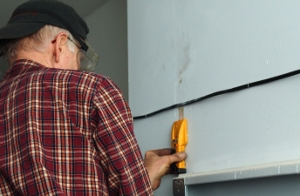 |
 |
5.12. If you haven't already you will need to assemble the high lift tracks. You will need these instructions for cutting your tracks, but for assembling them we recommend our watching our Garage Door High Lift Track Assembly YouTube video. Both sets of instructions are currently being revised this summer. If you ordered the tracks pre-assembled, remove them from the box. Since every high lift conversion project is different, you will probably have to make slight adjustments to your kit. |
| 5.13. Place the high lift track extension over the roller and line it up with the line you drew previously. |  |
 |
5.14. Mark the slots of the high lift track where you will secure the high lift extension to the wall. Verify that there are studs behind the drywall. |
| 5.15. Pre-drill the places where you will secure the new portion of high lift track. | 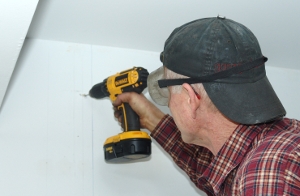 |
6. Install High Lift Hardware.
| 6.1. Secure the bottom portion of the high lift track to the top of the vertical track as shown. Make sure that the roller is in the track. This will keep the portion of high lift track from sliding down too low when you go to secure the angle iron to the wall. | 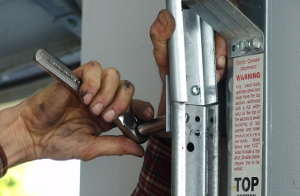 |
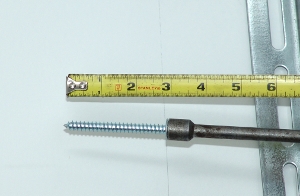 |
6.2. If you are securing the high lift track to a surface with drywall, you will want to have extra long 3-inch lag screws. |
| 6.3. Secure the high lift angle iron to the wall with the lag screws. | 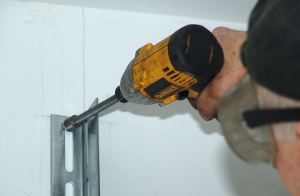 |
 |
6.4. Adjust the screws connecting the angle iron to the high lift plate as shown. This is only necessary if the angle iron does not sit flush against the wall. |
| 6.5. Secure the bottom bracket of the high lift conversion kit to the jamb. |  |
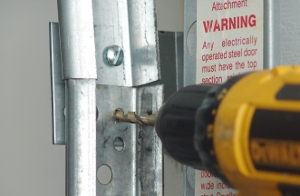 |
6.6. If necessary, drill a hole for a second track bolt to connect the vertical track to the high lift conversion kit. |
| 6.7. Secure the high lift conversion kit to the top of the vertical track. | 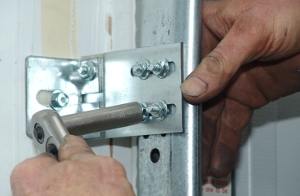 |
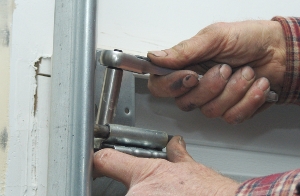 |
6.8. Adjust the top roller carrier and tighten the bolts to secure it to the top fixture. |
| 6.9. Repeat this process on the other side of the garage door. | 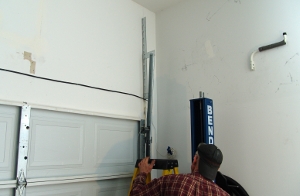 |
7. Reinstall Your Track and Bearing Plate.
| 7.1. From the back end of your horizontal track, measure the distance of your high lift conversion (that is, how much higher your garage door will open). Add to that distance the length of track that is left once you open your garage door. If you cut off this amount of track, the garage door will probably not open the whole way. You probably want to subtract several inches - around six inches - from this distance. Make a mark on the track at this new distance. If you are unsure of these distances, you can wait to cut the track until after you are done with the high lift conversion. |  |
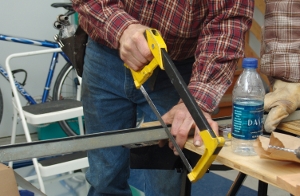 |
7.2. Cut the horizontal track at the mark you made. Do this for both sections of horizontal track. |
| 7.3. Cut two pieces of angle iron about 2-inches long. In this picture I am using a special angle iron cutter, but you can use a hack saw instead. | 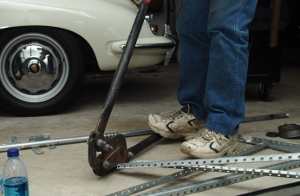 |
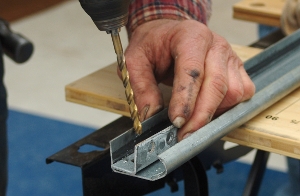 |
7.4. Place one of the pieces of angle iron inside the end of the track as shown. Drill holes in the track. |
| 7.5. Secure the angle iron to the track with two bolts. | 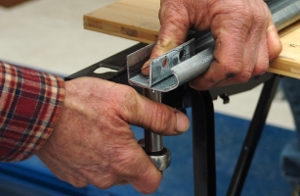 |
 |
7.6. Repeat this process for the other piece of horizontal track. |
| 7.7. Since the top of the high lift track is farther from the jamb than the top of the vertical track was, the horizontal track angle will need to be extended to reach the vertical high lift angle. Connect the 12" angle to the horizontal angle with a 5/16" carriage bolt and nut. Do not tighten at this time. | 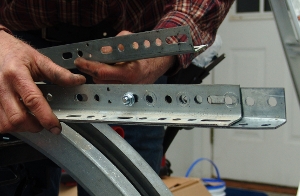 |
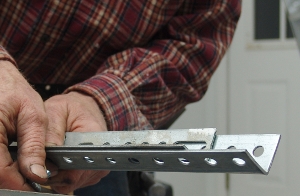 |
7.8. Do the same for the other horizontal track. |
| 7.9. Raise the horizontal track and put it on top of the high lift track to make sure it fits. | 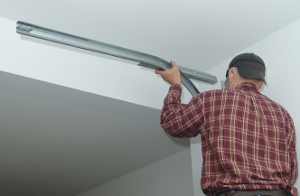 |
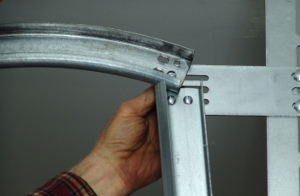 |
7.10. Connect the horizontal track to the top slot of the high lift plate with a track bolt, but do not tighten the bolt. |
| 7.11. Bolt the angle extension to the vertical angle with a 3/8" bolt and nut. |  |
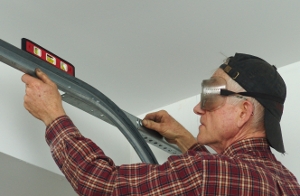 |
7.12. Check to see if the horizontal track is level. |
| 7.13. If the track is not level, adjust the position of the bolt that connects the horizontal track angle to the angle extension. If necessary, drill another hole. | 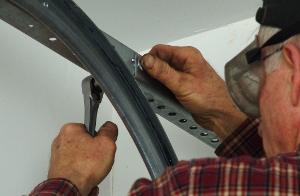 |
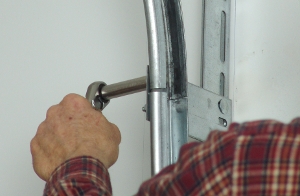 |
7.14. Secure the bottom of the horizontal track to the top of the high lift plate as shown. |
| 7.15. Depending on your garage door, the high lift conversion track may overlap with the horizontal track. If you do not fix this problem, you can damage your rollers. | 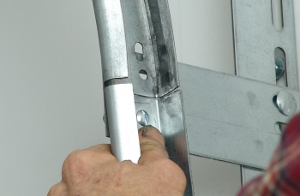 |
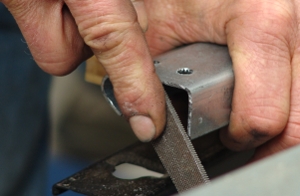 |
7.16. If there is an overlap, remove your piece of high lift conversion track from the high lift plates. File the end of the track. |
| 7.17. Reinstall the high lift track, checking to make sure that the pieces of track do not overlap. |  |
 |
7.18. Make sure that the horizontal track is still level after making the changes. |
| 7.19. Install bolts connecting the end bearing plate to the angle iron as shown. Do not secure the bolts. | 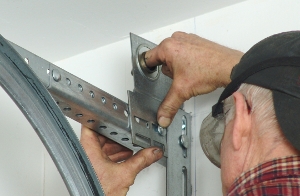 |
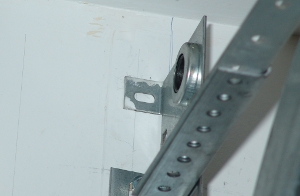 |
7.20. Check to see if the end bearing plate touches the jamb. If it is not, you will need make a few adjustments. |
| 7.21. If you cannot bring the end bearing plate closer to the wall without overlapping with the high lift angle iron, you will need to remove the end bearing plate and trim part of the high lift angle. | 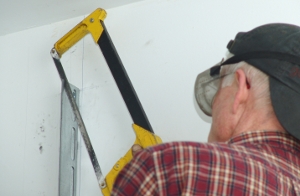 |
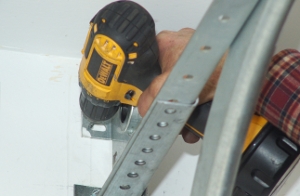 |
7.22. Reinstall the end bearing plate. Finger tighten the two bolts and nuts at the bottom of the plate. Pre-drill a hole for the end bearing plate. |
| 7.23. Secure the top of the end bearing plate to the wall with a 3" x 5/16" lag screw. | 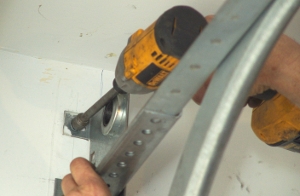 |
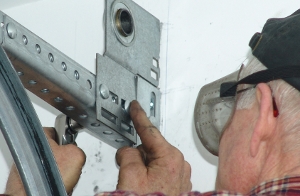 |
7.24. Tighten the bolts that connect the end bearing plate to the angle iron. |
| 7.25. Place your new high lift cable drum over the race of the bearing to make sure that there will be enough room without the cable drum rubbing against the ceiling. Adjust the high lift track length if necessary. |  |
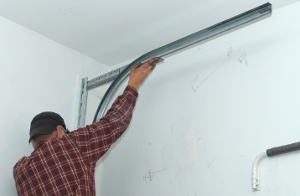 |
7.26. Install the horizontal track on the other side of the garage door. |
| 7.27. Trim the track as necessary. | 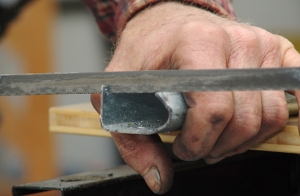 |
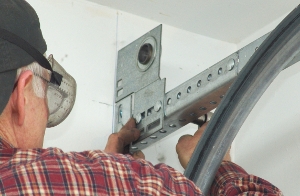 |
7.28. Install the end bearing plate. Trim the vertical angle if needed. |
| 7.29. Check for studs above the end of the horizontal track. | 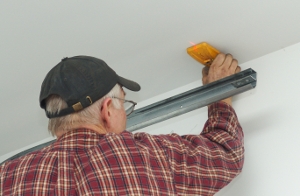 |
 |
7.30. Pre-drill the holes to install angle iron. This angle iron will be used to support the back of the horizontal track. Ideally, the horizontal track will be supported at about six inches from the end of the track. |
| 7.31. Secure the angle iron to the ceiling with 3" lag screws. | 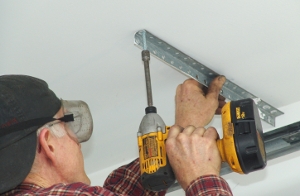 |
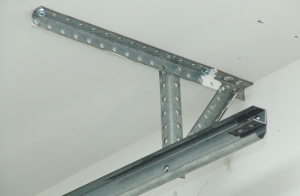 |
7.32. Connect the hangs to secure the horizontal track. Caution: when the garage door opens, the top of the door will be above the track. Therefore, you want to mount the diagonal piece of angle on the outside of the horizontal track. |
| 7.33. Repeat this process for the back of the other horizontal track. |  |
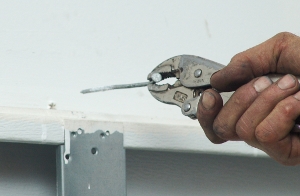 |
7.34. Remove the nail above the garage door. |
8. Install the Spring Anchor Bracket.
| 8.1. Slide the shaft into the end bearing plates. | 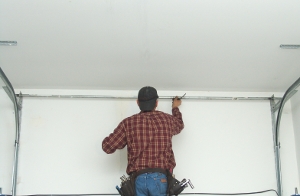 |
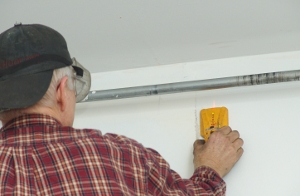 |
8.2. Look for studs around the center of the shaft. You will need to install your spring anchor bracket on a stud. |
| 8.3. Align the spring anchor bracket in the center of the shaft. Mark the holes you will use to secure the bracket. | 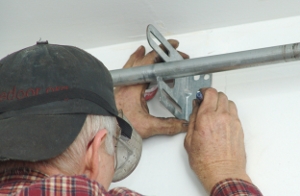 |
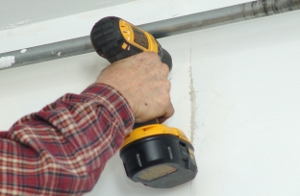 |
8.4. Pre-drill the holes. |
| 8.5. Install one lag screw on the top hole. If you do not have a slotted spring anchor bracket, wait to do the next few steps until you have the rest of the hardware on the shaft. | 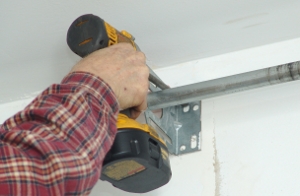 |
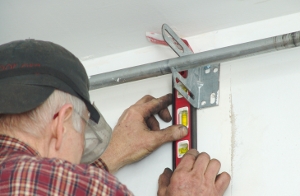 |
8.6. Plumb the spring anchor bracket. If it is not level, it can cause the stationary cone of the torsion spring to crack or cause the bearing to cut into the shaft. |
| 8.7. Adjust the position of the spring anchor bracket as necessary. |  |
 |
8.8. Secure the spring anchor bracket to the header. |
| 8.9. Remove the shaft from the end bearing plates. Set the shaft on the floor or workbench. |  |
9. Assemble the Hardware on the Shaft.
| 9.1. Slide the bushing on the shaft. If the shaft is bulging, distorted, or has paint on it, you may need to file the shaft to install the bushing. On this job, we replaced the bushing with a high-quality Freeway Bearing. If the new torsion spring is left wind, the right side of this shaft will go on the right side of the garage door. On the other hand, if the new torsion spring is right wind, the right side of this shaft will go on the left side of the garage door. | 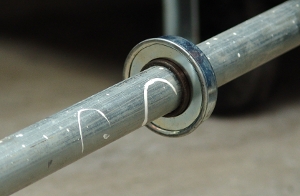 |
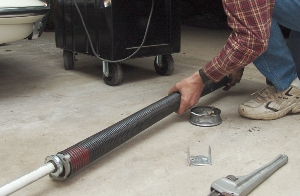 |
9.2. Slide the new torsion spring on the shaft with the stationary cone going to the bearing. If you are installing a pair of springs, slide the second spring onto the shaft on the other side of the bearing. The right wind spring goes on the left side of the door and has red paint on the winding cone, and the left wind spring goes on the right side of the door and has black paint on the winding cone. Note: If you install two springs, you need only one bushing or bearing if you have only one spring anchor bracket. Installing two bushings could cause a stationary cone to break. |
| 9.3. Slide the new high lift cable drum on the shaft. Note that this cable drum is painted black since it is on the right side of the garage door. Additionally, note the direction in which the cable will wind. If your cable drum winds in the opposite direction, you need to swap your cable drums. | 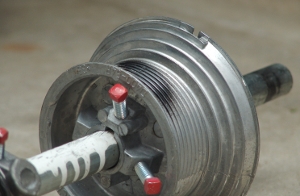 |
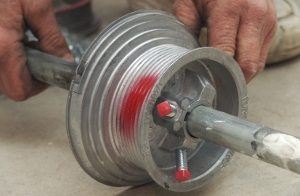 |
9.4. Slide the other cable drum on the other end of the shaft. Since this cable drum is on the left side of the garage door, it is painted red. The cable will wrap in the opposite direction on this cable drum. |
| 9.5. Lift the shaft up to the top of the door. |  |
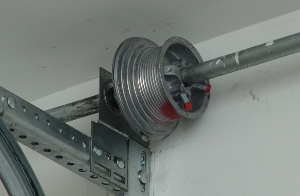 |
9.6. Insert the ends of the shaft into the end bearing plates. |
10. Install the Torsion Spring and Cable.
| 10.1. Insert the bolts in the stationary cones of the new torsion spring, and insert the bolts in the slots on the spring anchor bracket. Make sure that the bearing is inside the stationary cone. Finger tighten nuts on bolts until the stationary cone is flush against the center bearing plate. | 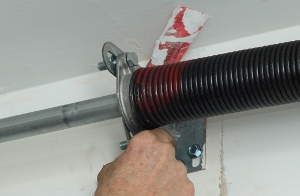 |
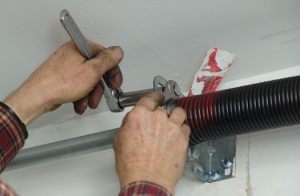 |
10.2. Forcing the cones by tightening the bolts may break a cone if it is catching on a bearing. Winding garage door springs with cracked cones can cause the springs to spin loose and the bars to fly. Secure the bolts. |
| 10.3. If you cannot get the stationary cones to finger-tighten against the center bracket, we recommend installing washers between the winding cone that houses the bearing and the spring bracket. This is a common problem with torsion springs on older Windsor garage doors because their steel bearings are often wider and they extend beyond the stationary cone. Raynor garage doors also have wider bearings that fit properly in their 2 1/4" stationary cones, but washers may need to be installed if their bearings are installed in 1 3/4" or 2" stationary cones, or if some of their older bearings are installed in their newer cones that are installed on older brackets. | 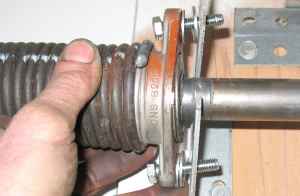 |
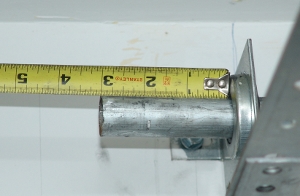 |
10.4. Measure the length of the shaft that extends out of the end bearing plates. The shaft should be centered on the garage door. |
| 10.5. Remove the old cable from the bottom fixture. You may need to use a screwdriver to get the cable off. | 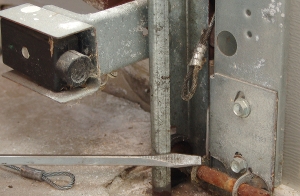 |
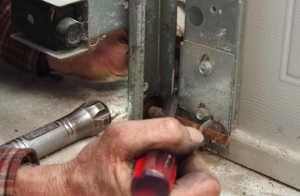 |
10.6. Install the new cable. |
| 10.7. Thread the cable up the garage door on the outside of the rollers as shown. | 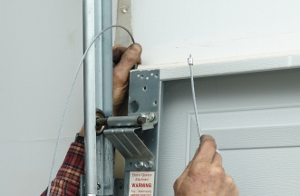 |
 |
10.8. Repeat this process with the cable on the other side of the garage door. |
| 10.9. If you are installing a jackshaft garage door opener like this one, you may need to do so now. On this job, I had to punch a small hole in the wall to get this operator to fit. Since most high lift garage doors do not have a lot of space on the sides, you may also have trouble installing the opener. On this opener I slid 3" of torsion shaft into the drive shaft of the opener. | 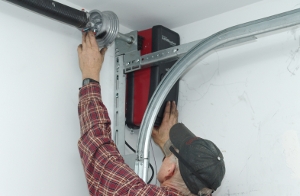 |
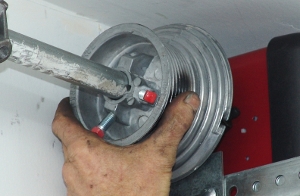 |
10.10. The next step is to slide the cable drum against the race of the bearing. |
| 10.11. Finger tighten the set screws on the cable drum until the drum will not turn on the shaft. |  |
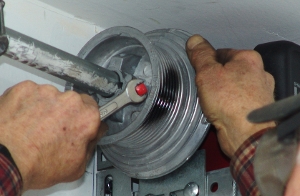 |
10.12. Secure the set screws by tightening them an additional 1/2 to 3/4 turns. |
| 10.13. A frequent problem for do-it-yourselfers and inexperienced garage door repairmen is getting the end of the cable to properly seat in the slot of the cable drum. I usually bend the end of the cable 90 degrees with my needle nose pliers as shown. | 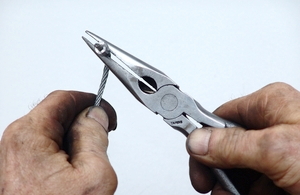 |
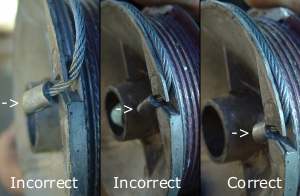 |
10.14. Bending the cable will help you avoid problems with the tip at the end of the cable catching on the end bearing plate and causing the cable to come off and the garage door to jam, cock, or fall. Check to make sure the cable is straight in the slot and not sticking out the side. Also the edge of the cable stop should not be pointing to the side as shown. The cable tip should fit completely inside the drum, with the rounded part facing out so the tip can't scrape the end bearing plate. |
| 10.15. After inserting the cable in the cable drum, twist the shaft to wrap the cable around the cable drum. The closer the drums are to the top of the door, the more cable there will be to wrap on the drums. For example, the cable on a door with 54 inches of high lift will wrap only half way around the outer groove of the drum. On a door with only seven inches of high lift, each cable will wrap around all the tapered grooves except for the last seven inches of each. You should never need to cut the cables we provide with our high lift conversion kits. | 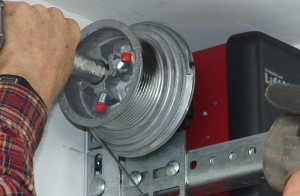 |
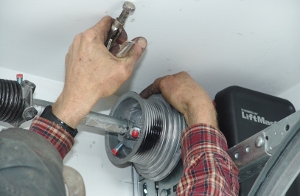 |
10.16. While pulling on the cable drum to keep the cable taut, vise grip the shaft so it cannot turn. |
| 10.17. Move to the other cable drum. Bend the cable. Wrap the cable around the cable drum. | 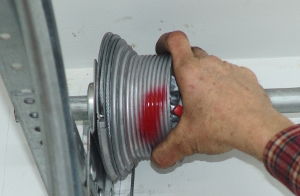 |
 |
10.18. Sometimes the cable will come loose and not rest in the grooves. |
| 10.19. If that happens, twist down on the cable drum and slide the cable back in the grooves. | 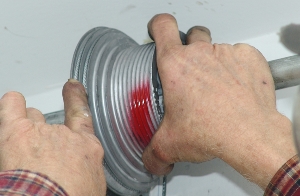 |
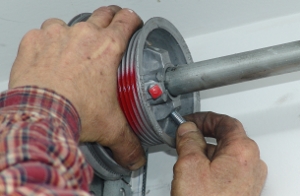 |
10.20. While pulling down on the cable drum to keep the cable taut, finger tighten the set screws. |
| 10.21. Secure the set screws another 1/2 to 3/4 turn. | 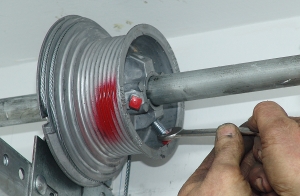 |
11. Wind the Torsion Spring or Springs.
| 11.1. Paint a white or light-colored line across the torsion spring. If you lose count of how many turns your have on the torsion spring as you wind it, you can count the number of times the white paint strip wraps around the spring. | 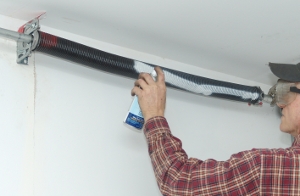 |
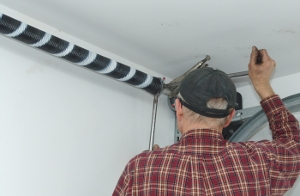 |
11.2. Wind the torsion spring. When you ordered your kit you should have received an email providing the number of turns to wind your spring or springs. For instructions on winding a single torsion spring, go to step 65 of our Single Torsion Spring Replacement tutorial. If you are installing two springs, see section 10 of our Torsion Spring Replacement tutorial. |
| 11.3. Remove the vise grip from the shaft. |  |
12. Basic Garage Door Maintenance
| 12.1. Raise the garage door slowly. Check the door balance. The door should stay down when closed, halfway when opened halfway, and open when opened. Add 1/4 turn of tension to the spring if the door will drop to the floor by itself from the halfway point. If the garage door won't stay on the floor, and if it pulls itself up when stopped halfway, close the door and remove 1/4 turn of tension from the spring. | 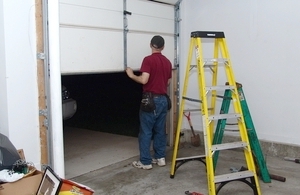 |
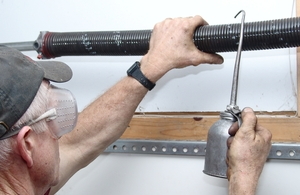 |
12.2. Oil the spring. The thicker the oil the longer it will last. I normally use forty weight motor oil, but multi-grade oils will work also. Squirt a stream across the tops of the springs and rub the oil into the coils. Do not oil the last inch of each end. |
| 12.3. Check the garage door at the floor. It should seal all the way across. If it doesn't you may need to adjust the drum on the higher side to get the door to level. Visit our tutorials for information on how to level your garage door. |  |
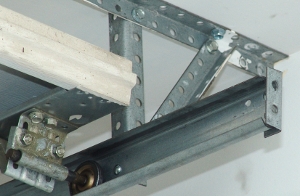 |
12.4. Another option for stopping the roller at the end of the track is to put a piece of angle iron as a plug as shown in this picture. This works just as well, and it may extend the life of your top rollers. |
| 12.5. You are now finished installing your high lift garage door! If you are installing an opener, you can go ahead and follow the manufacturer's instructions for installing the opener. | 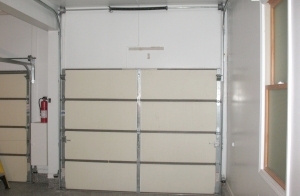 |
13. Conclusion
Since posting this tutorial we have developed a few short cuts to simplify your project. You can find these at our blog titled "High Lift Assembly Modifications."
We hear from many mechanics who relish the excitement of a challenge like this. Probably more often than not they are professional people such as engineers, doctors or lawyers who need extra space for their Porsches or Lamborghinis. By the time they order the hardware from us, they have already ordered the lift needed to raise their car into that empty space where their opener once was. I salute you men. I am working hard to help you do what you could have figured out yourself. Hopefully the information on this page will help you save at least one trip to the hardware store. You have my deepest respect and best wishes.
Dan Musick
President & Owner, DDM Garage Doors, Inc.
Get a Custom High Lift Conversion Quote for Your Door!


